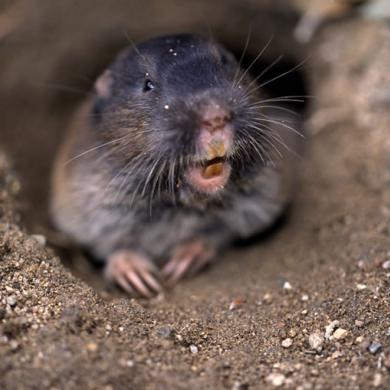
The Mazama pocket gopher in Washington State.
Photograph Attribution: Washington Department of Fish & Wildlife
https://wdfw.wa.gov/species-habitats/species/thomomys-mazama
Introduction
Native to the state of Washington, the Mazama pocket gopher is a fossorial mammal that highly contributes to the prairies where it lives by improving soil quality and aiding in plant seed dispersal. Due to habitat fragmentation and loss, the range of this species has been altered in such a way that several subspecies have been created across Pierce and Thurston counties in the Puget Sound region of Washington. According to the Washington Department of Fish and Wildlife, prairie coverage is 3% of what it once was in the South Puget Sound region. Additionally, predation by domestic and feral cats and dogs, reduced genetic diversity, and poor habitat quality are all significant threats to the Mazama pocket gopher. With these subspecies now facing a significant decline, the US Fish and Wildlife Service is tasked with drafting a recovery plan.
Comments
8-30-21
US Fish & Wildlife Service
5275 Leesburg Pike,
Falls Church, VA 22041-3803
Re: Draft Recovery Plan for Four Subspecies of Mazama Pocket Gopher
Dear Tom McDowell,
Environmental Review has reviewed the proposed document and has the following comments:
Section I: Habitat Connectivity & Genetic Diversity
-
Page 3 of the Draft Recovery Plan for Four Subspecies of Mazama Pocket Gopher (MPG) states that current populations of the four subspecies are much smaller and more fragmented compared to historical numbers. For this reason, these subspecies are particularly vulnerable to reduced gene flow, potential loss of genetic diversity, and destruction of population structure. Such losses are exacerbated by physical barriers such as Interstate 5 (I-5) which prevent interbreeding between populations of like and different subspecies. As noted in Carroll et al., 2014, “The most commonly proposed rule of thumb for connectivity suggests that at least one genetically effective migrant (but in some cases >10 migrants; Vucetich & Waite 2000) per generation into a population is necessary to minimize loss of polymorphism and heterozygosity (Allendorf 1983; Table 1, column 1).” What is the proximity of MPG populations relative to I-5, and what specific methods (translocation, wildlife corridors, captive breeding and release program, etc.) would be most effective at maintaining genetic diversity between populations on either side of the highway?
Section II: Habitat Quality/Restoration & Management Practices
-
Table 2 on page 21 of the Draft Recovery Plan mentions the “need for long-term management commitments to address threats of military training impacts, habitat loss and degradation, and MPG mortality factors.” What is the consensus surrounding the impacts of military training on fossorial mammals and/or prairie habitats? What research has been done to quantify these effects? Should a baseline study be completed prior to attempting to restore MPG populations around areas in which military training occurs?
-
On the topic of maintaining a resilient prairie ecosystem for MPG, implementing grazing along with other management practices such as prescribed fire may prove to have a synergistic effect on habitat restoration and maintenance. According to Henrichs (1997), large herbivores such as elk have historically helped maintain prairie ecosystems. Henrichs, 1997 also mentions a study conducted by Collins, 1987 in which species richness of forbs increased in response to grazing and burning. Forbs are an important food source for MPG, and for that reason, we recommend that grazing be considered as an additional management practice.
Section III: Public Outreach
-
The final RA listed under Priority 1b states the importance of managing feral and domestic cats and dogs and additionally Priority 2 RAs focus on information, outreach, and education. Creating educational materials to be dispersed in residential areas located near gopher habitat could be an effective means of raising public awareness. Perhaps if the public is cognizant of the detrimental effects of domestic and feral cats and dogs on wildlife, unnecessary predation of pocket gophers could potentially be reduced.
Section IV: Relevant Information
-
Finally, an issue encountered during the review process was the absence of documents such as Species Status Assessment / Species Biological Report (SSA / SBR) and the Recovery Implementation Strategy (RIS). Both documents contain useful information that was found outside of the contents of the recovery plan. The SSA for the Mazama pocket gopher can be found in the 2019 and 2020 publications of the Mazama Pocket Gopher Recovery Plan and Periodic Status Review but not in the most recent Draft Recovery Plan. The RIS is referenced in the Draft Recovery Plan but it is not included as part of the plan. Both documents were also on different websites (Washington Fish and Wildlife Office and Washington Department of Fish and Wildlife) and hard to locate. Due to the usefulness of the information in these documents, they should be included as appendices to supplement the rest of the plan.
Please direct all responses to these comments to the following email address: This email address is being protected from spambots. You need JavaScript enabled to view it.
Sincerely,
Matthew Coughlin (Associate in Maryland)
Reviewer
Miguel Andrade-Hall (Associate in California)
Sr. Reviewer
Environmental Review Inc.,
1792 Rogers Avenue,
San Jose, California 95112
References
Carroll, C., D.J. Rohlf, Y. Li, B. Hartl, M.K. Phillips, and R.F. Noss.
(2015). Connectivity conservation and endangered species recovery: a study in the challenges of defining conservation-reliant species. Conservation Letters. 8(2):132-138
Collins, Scott L. (1987). Interaction of disturbances in tallgrass
prairie: A field experiment. Ecology. 68(5): 1243-1250
Henrichs, Lisa. (1997). Grazing as a technique for prairie
restoration. Restoration and Reclamation Review.
University of Minnesota, St. Paul
Stinson, D. W. (2005). Washington State Status Report for the
Mazama Pocket Gopher, Streaked Horned Lark, and
Taylor's Checkerspot. Washington Department of Fish and
Wildlife, Olympia. 129+ xii pp.